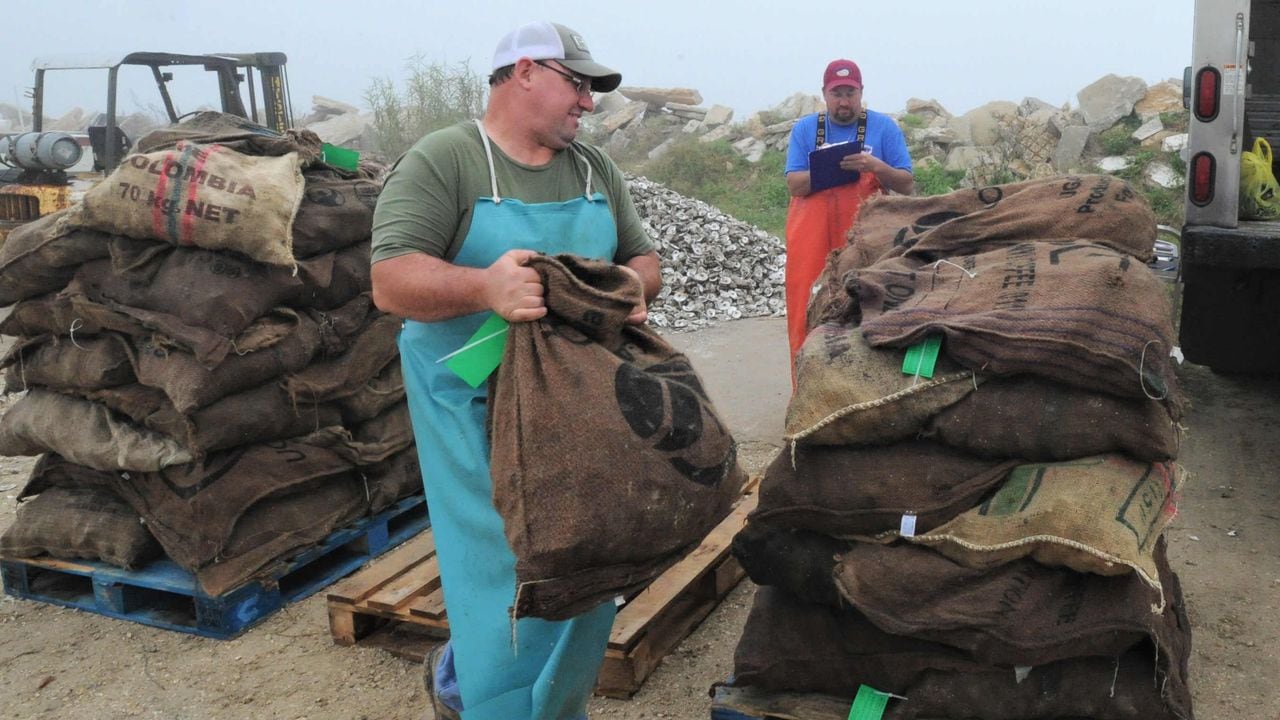Alabama wild oyster harvest declines; predator âinfestationâ blamed
An encouraging upward trend in Alabama’s wild oyster harvest stalled out this year, with harvesters bringing in almost 32,000 sacks since October.
As of Tuesday, the state’s online dashboard for the harvest showed 31,969 commercial sacks. That’s not a final number, but it’ll be close: On Tuesday the Marine Resources Division of the Alabama Department of Conservation and Natural Resources announced that the 2023-24 harvest will end at 2 p.m. Friday, Jan. 19.
Scott Bannon, director of the Marine Resources Division, characterized the season as one which was “very successful and built on the successes of the previous four years.” But he acknowledged challenges that resulted in a lower haul, down from two years in which harvesters brought in more than 40,000 sacks.
There was no harvest in 2018-19; state officials said their exploratory dives showed there weren’t enough oysters to make it worth the effort. From that dark year, things have improved: Harvesters brought in 11,258 sacks in the 2019-20 season and 22,070 in the 2020-21 season, the biggest haul since 2013-14. The next round brought a much bigger count of 49,314 sacks in 2021-2022, followed by a somewhat lower 44,408 sacks in 2022-23.
In Alabama, a sack amounts to 80-85 pounds of oysters in the shell. The wild oyster harvest takes place in an area at the southern tip of the county, north of the Dauphin Island Bridge, in Heron Bay and waters around Cedar Point.
In August, Marine Resources Division officials held an annual pre-season meeting with oyster harvesters and other interested parties in Bayou La Batre. They said their preliminary dives found reason for cautious optimism.
“The abundances were a little lower in Heron Bay,” John Mareska, assistant chief of fisheries, said of the results of the exploratory summer dives. “They were higher, though, on Cedar Point East and on Cedar Point West, so we’re really hoping to continue the trend we’ve had for the past three years of increasing harvests. Our goal would be to reach last year’s level, maybe even exceed it.”
That didn’t pan out. Scott Bannon, director of the Marine Resources Division, said via email that a perennial oyster predator was at least partly responsible.
“It has been a decent season but I doubt we harvest the same number of sacks as the last 2 years,” Bannon predicted in a Dec. 28 email. “We have had an infestation of oyster drills, a snail that drills a hole in the oyster and consumes it. They tend to appear when we have had high salinity levels. They can damage large portions of the reef in a relatively short period of time and we have to consider that mortality while reviewing our harvest.”
In Tuesday’s announcement of the season’s end, Bannon said that harvester participation, averaging 83 per day, was about half what it had been in the previous season.
Bannon told AL.com that prices had been “reasonable” but lower than the previous year. That might have contributed to a decline in the average number of boats fishing per day, he said. In Tuesday’s statement he said that despite variable prices, “harvesters were able to harvest and sell their catch for a profit which is beneficial to the families and the local economy.” The harvest had a “dockside value” of more than $1.2 million, according to ADCNR.
Ricky Harbison Jr. of Coden-based Anna’s Seafood heaves a sack of oysters onto a pallet on Feb. 11, 2020, the last day of Alabama’s oyster season. He and his brother Larry Harbison, in orange apron, were on hand to purchase freshly harvested wild oysters. Each sack weighs around 85 pounds; with 25 sacks, a loaded pallet weighs over a ton. (Lawrence Specker | [email protected])Lawrence Specker | [email protected]
The Marine Resources Division manages the harvest via a grid system that opens or closes waters in 500-square-meter areas; harvesters can use GPS-enabled phones to stay in the open areas. On Dec. 29, Marine Resources announced that it was closing some areas and reopening others. Bannon said the idea was to give harvesters another shot at areas that “did not have a lot of effort previously.”
While contemporary harvests have been encouraging, they remain a tiny fraction of harvests from the early 20th century, when productive reefs were spread throughout Mobile Bay. A variety of scientific efforts are under way to help re-establish thriving reefs that can withstand the various threats to oysters, such as drills, low oxygen, salinity extremes. In August, one project laid fresh limestone on the bottom in 77 acres of coastal water to provide habitat for larval oysters.
Spat take two years to mature into harvest-ready oysters, which gives some basis for predictions of what’s coming. At that August meeting, officials shared some worrisome news.
Jason Herrmann, a biologist with the Marine Resources Division, said divers had found decent numbers of mature oysters, uneven numbers of “sub-legal” oysters and, in many areas, very low numbers of spat. That’s not a good omen for the 2025-26 season.
“What I’m not seeing in my samples are the babies,” Herrmann said in August. “That’s worrisome as far as what happens next year or two years down the road.”
Kevin Anson, chief marine biologist for the Marine Resources Division, said Tuesday that some harvesters had reported seeing more spat during the season, but those anecdotal reports hadn’t been confirmed by systematic observation. Dives this summer should provide data on whether spring spawning has resulted in more spat on the reefs, he said.
